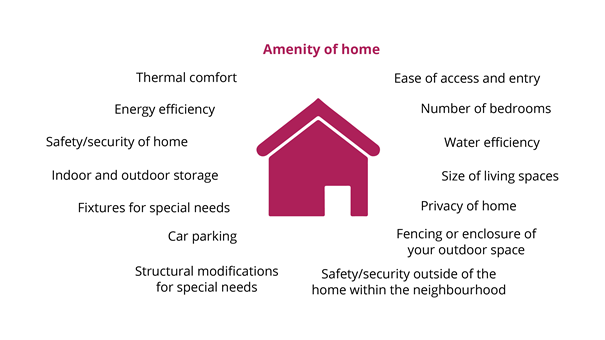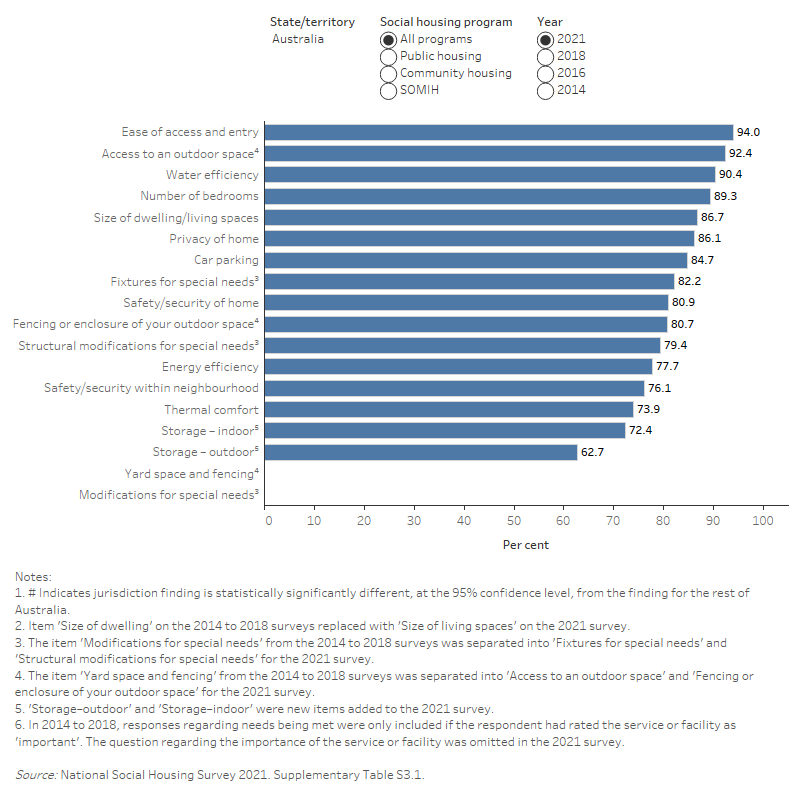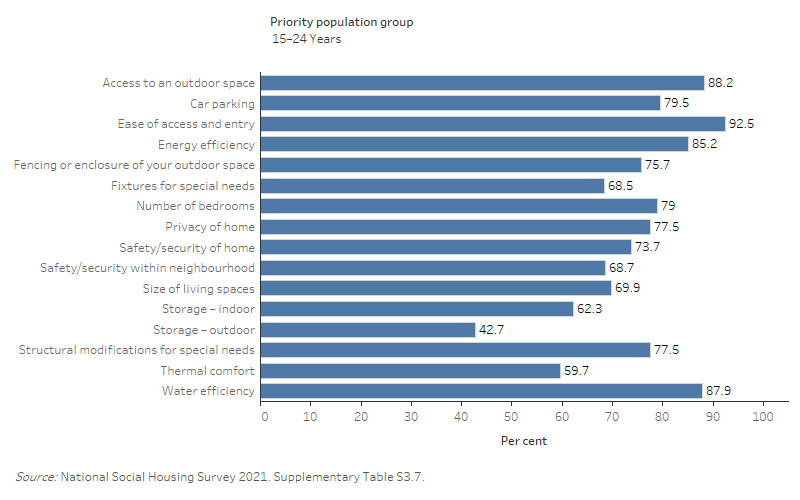Did amenities meet the needs of tenants?
Housing amenities are vitally important to improving social housing tenants’ standard of living. Many amenities such as thermal comfort, security, and modifications and fixtures for tenants with special needs as well as the overall quality of the property have been demonstrated to contribute to tenants’ health and wellbeing (Rolfe et al. 2020).
Measuring the extent to which tenants had their need for amenities met provides an insight into which amenities tenants had the greatest need for and which amenities tenants were most satisfied with.
NSHS question about whether amenities meet tenants’ needs
Information about whether features of a tenant’s home meet their needs was obtained from responses to the following question:
Please indicate if these features currently meet the needs of your household or not.
Respondents were asked to respond for a list of amenities (see illustration).

The majority of tenants reported that most of the features (that is, amenities) in their homes met the needs of their household (Figure Amenities.1, Table S3.1).
Although the rate of amenity needs met was high overall in 2021, there was variation between jurisdictions, between the housing programs and over time (Figure Amenities.1, Table S3.1). Nationally in 2021:
- the most commonly met amenity needs of public housing tenants were ease of access and entry (94%), access to outdoor space (92%) and water efficiency (90%); the least commonly met amenity needs were outdoor storage (63%), indoor storage (72%) and thermal comfort (73%).
- among community housing tenants, the most commonly met amenity need were ease of access and entry (95%), access to an outdoor space (93%) and number of bedrooms (91%); outdoor storage (63%), indoor storage (75%) and thermal comfort (77%) were the least met needs.
- the most commonly met amenity needs of SOMIH tenants were ease of access and entry and access to an outdoor space (both 93%) and car parking (90%) and water efficiency (89%); outdoor storage (56%), indoor storage (68%) and thermal comfort (69%) were the least met needs.
'My house was fitted with solar panels, our summer bill was 35%-45% lower than previous bills. This improved my standard of living.'
'I have a safe place to live, I have a roof over my head and a yard I can grow vegies in, I have a permanent address which makes it easier to study get metal, physical health care. I have a unit which is home, I look after it like it's mine, rent is very reasonable.'
'This place has no storage space so everything is in boxes still.'
Figure Amenities.1: Social housing tenants—needs met for an amenity (%), by social housing program, states and territories, 2021
This interactive horizontal bar graph shows the proportion of tenants whose needs were met by listed amenities, within each of the social housing programs over time. For Australia, ‘Ease of access and entry’ most commonly met tenant needs in all social housing programs in all years.

Are housing amenities meeting the needs of priority groups?
Some tenants have specific needs. The following sections provide results for selected priority populations compared with households who were not in that priority group.
'They haven’t done any of the things that were asked of them including request letters from my doctor asking for appropriate disability modifications.'
– Public housing tenant with a disability
'Still waiting for my roof which is leaking. When it rains water gets inside. And when it rains electricity goes out in half of the house.'
– SOMIH tenant
'It’s very hard to get things done, doesn’t seem to be enough staff to deal with everyone’s needs. You need spend a lot of your time hunting simple things and chasing answers. Also don’t like the way they don’t provide solutions, just reasons why they can’t help. For example, there is no parking but they have no interest in finding or providing a reasonable solution.'
In 2021 (Figure Amenities 2, Table S3.7) among tenants of all social housing programs:
- Indigenous households' needs were met less often than non-Indigenous households for most amenities, in particular, outdoor storage (53% compared with 63% respectively), fixtures for special needs (73% compared with 84%) and number of bedrooms (82% compared with 91%) (Table S3.2).
- Tenant needs were met among households with a person with disability for all surveyed amenities compared with households without a person with a disability, in particular, energy efficiency (69% compared with 81% respectively), structural modifications for special needs (72% compared with 83%), thermal comfort (66% compared with 77%) and fixtures for special needs (75% compared with 85%) (Table S3.3).
- Among tenants who had experienced homelessness in the last 5 years, a lower proportion reported that their needs were met across most amenities compared with other tenant groups, in particular, safety and security of the home or within the neighbourhood, privacy of the home and size of living spaces (Table S3.4).
- Tenants living in households with children less commonly reported their needs were met across most of the amenities compared with those living in households without children, in particular, indoor storage (55% compared with 76% respectively), thermal comfort (59% compared with 77%) and size of living space (73% compared with 90%) (Table S3.5).
'Kids have their own rooms, own space. Closer to schools. Better for everyone's mental health. There are a lot of benefits. Big back yard.'
Figure Amenities.2: Social housing tenants—needs met for an amenity (%), by priority group cohort, 2021
This interactive horizontal bar graph shows the proportion of tenants whose needs were met by listed amenities, for the priority population groups. Outdoor storage least commonly met the needs of all priority groups.

References
Rolfe S, Garnham L, Godwin J, Anderson I, Seaman P and Donaldson C (2020), Housing as a social determinant of health and wellbeing: developing an empirically-informed realist theoretical framework, BMC Public Health, 20(1):1-19


